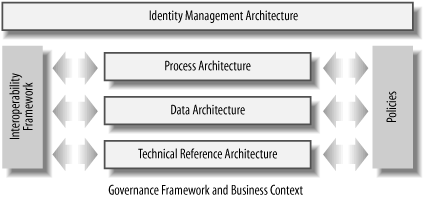Identity Management Architecture Components
Building an IMA involves creating a series of interrelated components . Figure 13-1 shows a schematic diagram of these components.
The IMA is created within a governance framework that lays the ground rules and a business context that lays out long-term business goals, principles, and objectives. Chapter 14 will outline how you can build a governance framework for your organization. Chapter 14 will also show you how to understand and document the business context.
The process architecture determines how your business accomplishes identity tasks now and how they should be accomplished. Identity processes are evaluated and improved using a maturity model for identity management that gives clear direction on how processes should be changed to improve your identity infrastructure.

Figure 13-1. Components in an identity management architecture
Chapter 15 will discuss the identity management maturity model and show how to use it in your organization.
The data architecture is a model of the identity data in your organization. Building an identity data architecture involves determining what data you have and then standardizing data practices in three important areas: categorizing, exchanging, and structuring data. Chapter 16 will discuss this process.
Identity policies are a crucial way for your organization to set direction, communicate standards, ...
Get Digital Identity now with the O’Reilly learning platform.
O’Reilly members experience books, live events, courses curated by job role, and more from O’Reilly and nearly 200 top publishers.

